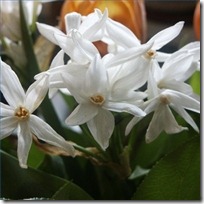Cloning may sound like science fiction, but when it comes to plants, it’s been going on for years. While cloning of animals is relatively new and still controversial, horticulturalists know that cloning was happening in the garden long before the word "cloning" hit the news. That’s because "cloning" simply refers to the form of asexual reproduction that results in an offspring that is genetically identical to the single "parent." Home gardeners can clone most plants; with bulbs, the options are more limited. Nonetheless, you can readily clone the popular and fragrant paperwhite narcissus at home.
Difficulty: Easy
Instructions
Things You’ll Need:
- Mature paperwhite plant(s)
- Spade
- Sterile planting medium
- Sharp knife with a blade long enough to bisect plant’s bulb
- Fungicidal powder
- Sterile rooting medium
- Rooting hormone
- Water
Cloning by Separation
-
Narcissus and daffodil bulbs are medium-sized and resemble shallots when mature.
Dig gently around the base of a mature (3 to 5 years old) paperwhite narcissus plant, using a hand trowel. Exposing the entire bulb system.
-
Examine the plants for bulblets or joined bulbs — smaller bulbs that have grown off from the main bulb. They will often have their own hairy roots and their own stems and leaves on top.
-
Separate the smaller bulbs or bulblets, pulling them away from the main bulb.
-
Restore the soil around the original plant and pat it into place.
-
Plant the divided bulbs in a pot mostly filled with sterile potting medium, with the stem end pointing up about 2 inches below the surface. They can also be planted outdoors at the same depth.
-
Water the new plants and the replanted original bulb.
Cloning by Scaling
-
Bulbs are root structures that include nutrient-rich stem sections.
Sterilize the knife with boiling water and allow it to air dry.
-
Dig up the bulb, using a hand trowel, and gently remove it from the soil.
-
Slice horizontally across the bulb, leaving at least an inch of bulb material at the root end.
-
Cut the bulb vertically, ensuring that some root section remains with each section and that each section contains at least two "scales" or layers of bulb.
-
Dust each scale section with fungicide.
-
Dip the root (bottom) end of the scale section into rooting hormone.
-
Plant each scale section in sterile rooting medium at a depth equal to the length of the scale section.
-
Gently water the plantings.
Tips & Warnings
-
You can make your own potting medium out of a combination of peat, vermiculite, sand and sterilized compost. For rooting medium, you can use sterile sand or vermiculite, which assists in drainage.
-
Keep newly planted scalings in a warm and moist environment until they sprout.
-
Cloning (asexual reproduction) of paperwhite narcissus is similar to other bulbs, such as lilies, amaryllis and tulips. Larger size bulbs will yield more scaling sections, and some structures — like those of lilies — will yield more bulblets per bulb. The same principles apply in cloning most bulbs.
-
Wait to separate or scale your narcissus until blooming is finished. Outdoor propagation of narcissus is best in early summer, if your weather isn’t too hot, or early fall. Indoor propagation can take place year-round.




Deprecated: strpos(): Passing null to parameter #1 ($haystack) of type string is deprecated in /home/agriviek8Qv/agriviet.net/public_html/wp-includes/comment-template.php on line 2522